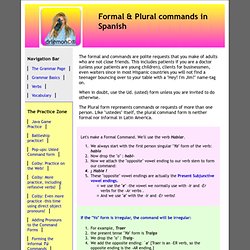

¿Es de Pili el podcast "dpili"? Spanish Verbs: Online Spanish Verb Conjugation Trainer - Practice Spanish - learn Spanish. Fiestas & Festivals in Spain. Spanish fiestas symbolise the very essence of Spain and the Spanish people.

They're colourful, vibrant, usually extremely noisy, often chaotic and always great fun. The origins of many of the country's countless fiestas lie in religious feasts, often honouring a patron saint. It's the same in northern Europe where many public holidays were born out of religious 'holy days'. But northern Europe simply can't compete with Spain when it comes to turning a religious celebration into a riotous round-the-clock knees up. Perhaps it's the warm weather or maybe it's the exuberant, uninhibited nature of the Spaniards who just love to party. Every day throughout the year there are fiestas taking place somewhere in Spain, either at a local, regional or national level. These may revolve around the major religious festivals such as Christmas, Easter and All Saints (Halloween) or they may be highly localised events, with their origins in obscure local folklore.
The hottest fiesta of them all! Spain Culture:Festivals in Spain. Spanish to English Translation, Dictionary &Translator /... ¿Es de Pili el podcast "dpili"? Lots of Spanish Idioms! Spanish Idioms. Webster's dictionary defines an idiom as: "1) the dialect of a people, region,etc., 2) the usual way in which words of a language are joined together to express thought; 3) a conventional phrase or expression having a meaning different from the literal; 4) a characteristic style. " Webster's New World Dictionary,Compact School & Office Edition - The World Publishing Company, 1967 The use of idioms allows you to expand your fluency in a language. Spanish Idiom Dictionary. Spanish idioms are essential to understanding and communicating with native speakers.

Because Spanish is spoken in so many different countries, extra care is required when learning idioms. Make sure to pay attention to who is saying what under what circumstances before you attempt to use anything but the most common expression. Amusing Spanish Idioms. See also Spanish Slang, Spanish Words & Phrases An idiom is a phrase that is understood to have a meaning different from its literal meaning.

For example, in English when we say “it’s raining cats and dogs” we mean it’s raining heavily, it’s a downpour. Like the cats and dogs example, idioms are fun, colorful expressions and the direct translation of an idiom from one language to another is often hilarious. Spanish Verb Conjugation Activities. Spain: Spanish Language.
Welcome to our guide to Spain!

This is useful for anyone researching Spanish culture, customs, manners, etiquette, values and wanting to understand the people better. You may be going to Spain on business, for a visit or even hosting Spanish colleagues or clients in your own country. Remember this is only a very basic level introduction and is not meant to stereotype all Spanish people you may meet! Facts and Statistics Location: Southwestern Europe, bordering the Bay of Biscay, Mediterranean Sea, North Atlantic Ocean, and Pyrenees Mountains, southwest of France Capital: Madrid Climate: temperate; clear, hot summers in interior, more moderate and cloudy along coast; cloudy, cold winters in interior, partly cloudy and cool along coast Population: 40,280,780 (July 2004 est.) Ethnic Make-up: composite of Mediterranean and Nordic types. Spanish Pronouns. A Pronoun in Spanish as well as in English is like a shortcut to refer to a noun, a word that stands for or represents a noun or noun phrase, a pronoun is identified only in the context of the sentence in which they are used.

So you must have a prior idea about who "he or she" "él or ella" is. In English we find "me, her, what, that, his", In Spanish they're used pretty much the same way, the main difference is that in Spanish most pronouns have a gender, masculine or feminine and rarely neuter to unknown objects or ideas. Types of pronouns include personal pronouns (refer to the persons speaking, the persons spoken to, or the persons or things spoken about), indefinite pronouns, relative pronouns (connect parts of sentences) and reciprocal or reflexive pronouns (in which the object of a verb is being acted on by verb's subject). Formal & Plural commands in Spanish. The formal and commands are polite requests that you make of adults who are not close friends.

This includes patients if you are a doctor (unless your patients are young children), clients for businessmen, even waiters since in most Hispanic countries you will not find a teenager bouncing over to your table with a "Hey! I'm Jim! " name-tag on. When in doubt, use the Ud. (usted) form unless you are invited to do otherwise. The Plural form represents commands or requests of more than one person. Basic Spanish Exercises (with answers) Free Spanish exercises - TODO-CLARO.COM. How to Teach Commands to First Year Spanish Language Students. Written by: Heather Marie Kosur • edited by: Rebecca Scudder • updated: 3/2/2012 The following article describes a first year Spanish lesson plan for teaching basic commands in Spanish and includes examples to illustrate the Spanish imperative verb form. An optional refresher on the imperative mood in English is provided. Imperative Mood Lesson PlanThe following lesson plan can be used by Spanish teachers to introduce the imperative mood to English-speaking Spanish students.
The first part introduces the imperative to students by explaining the use of the verb form in English. The second part describes how to form the imperative in Spanish and includes charts for each verb type and useful tips.The Imperative Mood in EnglishUse as much or little of this section for your students as you think the class needs. Free Spanish Lessons. Learn Spanish Grammar A-S-L. Live Spanish TV - Watch Internet TV channels from Spain. Preterite Tense Verb... Spanish Numbers. Home / Grammar / Topic Notes: The written lesson is below.Links to quizzes, tests, etc. are to the left.

Here are the numbers 1-10: 1. uno 2. dos 3. tres 4. cuatro 5. cinco 6. seis 7. siete 8. ocho 9. nueve 10. diez The number "one" changes from "uno" to "un" before a masculine noun. un libro. Learn Spanish & Phrases & Vocabulary & Bars.